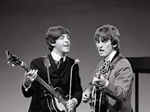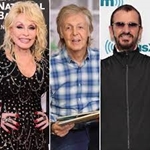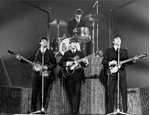- Register
- Log in to Tune-In
- Wishlist (0)
-
Shopping cart
(0)
You have no items in your shopping cart.
Beatles News

The Beatles’ compilation albums 1962-1966 and 1967-1970 (also known as the Red and Blue Albums, owed to the distinctive cover art), re-enter Billboard’s Top Album Sales chart (dated Nov. 25) at Nos. 6 and 5, respectively, following their expanded reissue on Nov. 10.
The titles sold 22,000 and 24,000 in the week ending Nov. 16 in the U.S., according to Luminate. Each told sold less than 500 copies in the previous week. For both titles, it is their largest sales week since the week ending Dec. 24, 1994, when they sold 37,000 and 40,000, respectively.
Related
Upon their original release in 1973, the 1962-1966 album contained 26 songs, while 1967-1970 held 28 tunes. (On the Billboard 200 chart, 1967-1970 reached No. 1, while 1962-1966 peaked at No. 3.) For the 2023 reissue, 21 songs were added to the two albums — 12 songs on 1962-1966 and nine on 1967-1970. The latter’s additional cuts include the recently released new single “Now and Then,” which debuted in the top 10 on the Billboard Hot 100 – marking the Fab Four’s 35th top 10-charting hit.
Source: Keith Caulfield/billboard.com

Rush bandleader Geddy Lee opened up about how the Beatles musician provided the band with a little encouragement
If Rush tours again, fans might need to thank Paul McCartney for it.
In an interview with Rolling Stone published Sunday, Geddy Lee, 70, opened up about how The Beatles musician, 81, tried to convince Rush — who completed their final tour in 2015 — to tour again.
The Rush bassist and bandleader revealed in the conversation that it was Dave Grohl, whom he calls "a very lovely man," that initially introduced them at one of Taylor Hawkins' tribute concerts.
"Dave [Grohl] was so sweet. He comes up to us at rehearsal and he goes, 'Paul McCartney’s up next to rehearse, and he’s outside, and he said to me, ‘Dave, I’ve never met anyone from Rush before.' And I said, 'I’ve never met him! Bring him in, please.' And he came in," Lee told the outlet.
Although it seemed like the "Let It Be" performer wasn't exactly familiar with Rush's music, Lee "got the sense he knew who we were and had heard about us." That didn't stop him from encouraging Rush to get back on the road.
"He had never listened to us. So at the show, he was there. He watched details

When George Harrison sat down with Guitar Player's then Editor At Large Dan Forte for the cover story of the November 1987 issue, he was promoting the release of his 11th solo album, Cloud Nine. The lead single from the album – a version of the Rudy Clark song Got My Mind Set On You – would take him to number 1 in the Billboard charts but, affable and humble as ever, Harrison was happy to look back over his entire career, including the recording of While My Guitar Gently Weeps, The Beatles' Hamburg days, his love of Gretsch guitars and much more. Here we reprint that interview in full…
With all that's been written about the Beatles and their indelible stamp on music, fashion, and pop culture, they are individually still criminally underrated as musicians. Not only did they inspire a generation to plug in electric guitars and harmonize, but they also influenced how guitar players played, how bassists played, how drummers drummed, and how singers sang. And while each later took turns reinforcing the obvious – that something magical and greater-than-the-sum happened when they played as a band – their separate instrumental contributions can't be overemphasized.
Source: Dan Forte/guitar details

He was always the 'mystic' one.
George Harrison even wrote a song called 'Mystical One' later in his career, slightly riffing on his title within The Beatles because of his fascination and eventual conversion to Eastern beliefs.
Well, according to his widow Olivia Harrison, there may be some substantiation to his nickname where their recent single 'Now and Then' is concerned.
Posting a video on to George's official Instagram profile, she revealed the "surprising magical" backstory about the artwork for the vinyl.
Olivia explained that the song's title appeared on a ragged old clock George found in a shop some years back.
He was drawn to it, as there was a Scrabble letter stuck to the clock which said, "Now And Then", which would turn out to be the title of The Beatles' final ever song.
Strangely enough, Olivia dug out the clock and renovated it recently, before Paul McCartney got in touch to see how she felt about releasing the forgotten demo.
"We were in this store, George saw this clock made out of bits and pieces and it had some Scrabble letters and it just said 'Now And Then'," Olivia Harrison recalled about the first time they came across the clock.
Source: Thoma details

In the summer of 1968, Paul McCartney was reading Melody Maker when he stopped on a quote from Pete Townshend.
“Pete said: ‘We’ve just made the raunchiest, loudest, most ridiculous rock’n’roll record you’ve ever heard,” McCartney recalled. “I never actually found out what track it was that The Who had made, but that got me going, just hearing him talk about it. I was always trying to write something different, trying to not write in character, and that one little paragraph was enough to make me make a move. I thought we should a do a song like that, something really wild, and I wrote Helter Skelter.”
McCartney was thinking about the fairground slides of his childhood, coupled with the sense of social unrest in the world that summer. “I was using the symbol of a helter skelter as a ride from the top to the bottom – the rise and fall of the Roman Empire – and this was the fall, the demise, the going down,” he said.
On July 18 The Beatles learned the song and recorded three extended takes at Abbey Road Studios. The first two were 10 and 12 minutes respectively, the third stretched to 27:11. A four-minute excerpt of the latter, rel details

Paul McCartney is a very busy man these days. He recently dropped a new single with The Beatles, "Now and Then," which became a quick global hit and helped him make history in a number of ways. He is also in the middle of touring Brazil, with dates into the end of 2023. On top of that, he's also got a successful podcast, and likely other projects in the works. Now, according to one report, he might be considering heading to Las Vegas for a very special reason.
According to the New York Post, McCartney is one of a select few names being considered as the next act to headline the Sphere. The team in charge of the multi-billion dollar high-tech venue is on the hunt for a second name that is popular enough to bring in huge crowds and prestigious enough to keep the brand strong, and McCartney could be just the right fit.
The venue was inaugurated only a few weeks ago by U2. The band's appropriately-titled U2:UV Achtung Baby Live at Sphere concert residency launched in late September, and while it was initially set to run only a few weeks, the group extended it. Now, the rockers have dates into February 2024, but after that, nothing is scheduled.
Source: Hugh McIntyre/forbes.com

Musician, songwriter, and occasional actor Ringo Starr appreciates his memories of The Beatles but does not let them take hold of him. In the December 2023/January 2024 issue of AARP The Magazine (ATM), the legendary drummer opens up about his early musical memories, his joyous path through life, his new EP Rewind Forward and his ongoing relationship with The Beatles 60 years after their iconic appearance on The Ed Sullivan Show.
While Starr’s life has always revolved around music, his memories of music as a child hold a significant influence on him. He recalls how his stepfather shared both music and an open mind with him, moments so poignant that he made it a point to share music with his own children the same way.
He also shared with ATM about his time with The Beatles and the brotherhood they shared. From laughing off rumors of John Lennon following him around with a pen and paper to note his every thought to his memory of the band hearing their song “Love Me Do” on the radio for the first time, no one could understand The Beatles like The Beatles. Starr’s fondness runs so deep that he never could join another band full-time. However, he’s never let that fondness hold him back. details

To some, the opening bars of ‘La Marseillaise’ signify gallic pride, the first notes in the French national anthem. To others, it represents The Beatles, and one of their crowning achievements.
Released in the long hot summer of 1967, ‘All You Need Is Love’ became an anthem for the flower generation, with its simplistic lyrics rejecting the pace of the material world for an alternative form of existence. A real ear-worm, it was aired during the ambitious globe-reaching Our World broadcast, and went on to become an inter-continental smash.
Closing with a reprise of ‘She Loves You’, the basic yet also quietly ambitious track placed The Beatles in a modern cultural pantheon, while also offering insight into some of their basics social treatises. To George Harrison, it was “a perfect song”.
Speaking to VH1, he said: “It was just a perfect song because it was so simple. The message was so simple, and it was a good excuse to go right into that culture that was happening and give them a theme tune”.
Source: Robin Murray/clashmusic.com

Dolly Parton sent a "love note" to Beatles Sir Paul McCartney and Ringo Starr.
The '9 to 5' hitmaker was "very humbled" after the surviving members of the legendary rock'n'roll group agreed to re-record their 1970 classic 'Let It Be' for her rock record 'Rockstar' after she sang their praises in the special request.
She told NPR of approaching Paul, 81, and Ringo, 83: "So I just sent them a love note through their managers, and I just said what I was doing. And I said, I didn't want to put you on the spot, but I'd love to have you sing with me on my rock album. And if you're interested, call me at this number. And all the people I reached out to said, yes, we'd love to, and I was very honoured and very proud and very humbled by that."
Dolly has confessed to feeling like she was "hitting on" the artists she asked to feature on the star-studded album.
Source: perthnow.com.au
details
From “I Want to Hold Your Hand” to “Now and Then,” the music of The Beatles has continued to serve as the soundtrack to our lives, and if you’re a fan of the Fab Four, each album will likely represent something different to you. At the same time, one of their most popular is simply titled The Beatles, although it’s better known as The Beatles’ The White Album , a double-disc released in November 1968 with 30 songs.
The Beatles’ White Album songs, and there are a lot of them, go a long way in both showcasing the strength and creativity of the group while at the same time providing proof positive that John Lennon, Paul McCartney, George Harrison and Ringo Starr were going their separate ways musically. Indeed, the band actually broke up less than two years later.
The album’s origins can be traced back to the fact that in February 1968, The Beatles — along with wives, girlfriends and friends — traveled to Rishikesh in northern India to participate in a Transcendental Meditation training course at the ashram of Maharishi Mahesh Yogi.
Source: Ed Gross/firstforwomen.com

After long nights out, John Lennon would return to his room in a terrible mood. George Harrison tried to avoid him when this happened.
While The Beatles went to Germany, George Harrison spent multiple nights trying to avoid John Lennon’s attention. The band prepared for their performances by drinking beer and taking stimulants. The combination made Lennon aggressive, and he often started looking for a fight. Some nights, Harrison would pretend he was asleep to avoid Lennon’s attention.
In Hamburg, The Beatles played long nights of shows. In order to stay awake and energetic in their performances, they began taking Preludin, a stimulant.“This was the point of our lives when we found pills, uppers,” Ringo Starr said in The Beatles Anthology. “That’s the only way we could continue playing for so long. They were called Preludin, and you could buy them over the counter. We never thought we were doing anything wrong, but we’d get really wired and go on for days. So with beer and Preludin, that’s how we survived.”
Source: Emma McKee/cheatsheet.com

George Harrison shares his favorite albums that he can’t live without. Here, The Beatles’s guitarist George Harrison reveals his 5 albums of all time.
In mainstream media, George Harrison is known as “The Quiet Beatle.” Harrison, born in Liverpool in 1943, became famous as the band’s leading guitarist. Over the course of The Beatles‘ last years, Harrison’s songwriting skills were increasingly apparent, with songs like “While My Guitar Gently Weeps,” “Something,” and “Here Comes the Sun” displaying his ability to construct enduring melodies and heartfelt lyrics. In particular, His song “Something” has been hailed as a masterpiece of romantic music and serves as a testament to his skill as a songwriter.
In addition to his work with The Beatles, Harrison enjoyed a fruitful solo career, highlighted by the release of the triple album “All Things Must Pass” in 1970. The album, highlighted by the global smash song “My Sweet Lord,” showed Harrison’s spiritual inclinations and was a financial and important success.
He was also unique because he was interested in faith and Indian culture, mainly details

As any Beatles student knows, the four made no secret of their love for R&B. Before they conquered the world, they cut their teeth on tracks by Little Richard, Arthur Alexander, Smokey Robinson and the Miracles, Larry Williams and numerous Motown acts. Throughout their careers, The Beatles (as a group and as solo artists) interpreted soul and blues in a unique fashion, adding that pounding Ringo Starr backbeat and John Lennon’s slightly raspy vocals to lend them an edge. “All I’ve Got to Do,” a standout track from their second album, blends rock and soul in a particularly sophisticated yet catchy way.
In 1980, primary composer Lennon labeled “All I’ve Got to Do” as “me trying to do Smokey Robinson again.” While Lennon lacks Robinson’s patented falsetto, he does turn in a memorable vocal on this song. In fact, his emotion-packed singing ranks as one of his finest performances, both in his Beatles and solo years. “And the same goes for me, whenever you want me at all – I’ll be there, yes I will, whenever you call,” he cries, his voice rising in pitch and volume.
Source: Kit O'Toole/somethingelsereviews.com

Sir Paul McCartney had doubts all the way through finishing The Beatles’ last song Now And Then - but knowing the late John Lennon would have “loved it” kept him going.
From a demo Lennon recorded, they used groundbreaking audio technology to beautifully restore his vocals and “reunite” the group - which also included the late George Harrison and drummer Sir Ringo Starr, 83 - one last time.
However, McCartney, 81, admits he questioned himself throughout the process about whether or not they should be doing it.
He told MOJO magazine: “It’s strange when you think about it. There’s him in his little apartment in New York City banging away at his piano doing a little demo, and... our team has restored it so now it’s a crystal clear, beautiful vocal. How much would John have liked that?! He would have loved that.”
McCartney asked himself: “Is it a bit inferior? Is it something we shouldn’t do? Am I pushing the envelope too far? But every time I thought like that, I thought, ‘wait a minute, let’s say I had a chance to ask John. Hey John, would you like us to finish this last song of yours?’ I’m telling you, details

The Beatles’ “last song ever,” released 61 years after their first single, was bound to be significant.
But how did John Lennon’s lo-fi, 40-something-year-old cassette recording of Now and Then — deemed “fucking rubbish” by George Harrison during the failed 1995 attempt to revive the song — become an instant No. 1 chart hit and worthy addition to the Beatles’ catalogue in 2023?
Beyond the AI-assisted salvage of Lennon’s voice from the noisy cassette, it is worth examining Lennon’s raw materials, and the strategies that made the unfinished late-1970s musical sketch a Beatles’ song.
Had Harrison told Lennon himself that the song was rubbish, Lennon might have responded, “Well I’m not finished with it yet, am I mate?”
Lennon’s original “demo tape” was not made for formal presentation (to a music publisher, for instance).
It was a personal memorandum to capture basic song ideas — something musicians do all the time. If they stopped there, Yesterday would be Scrambled Eggs, and the Rolling Stones’ Satisfaction would be one minute of Keith Richards’s signature riff and 4 details
